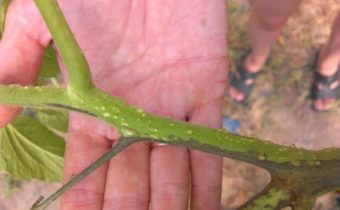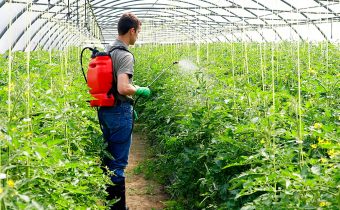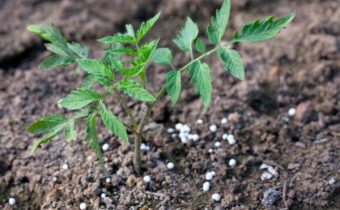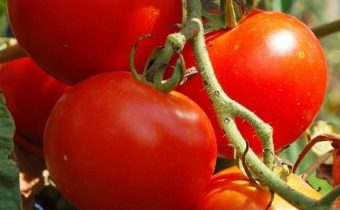Tomatoes suffer from necrosis: what to do, how to treat?
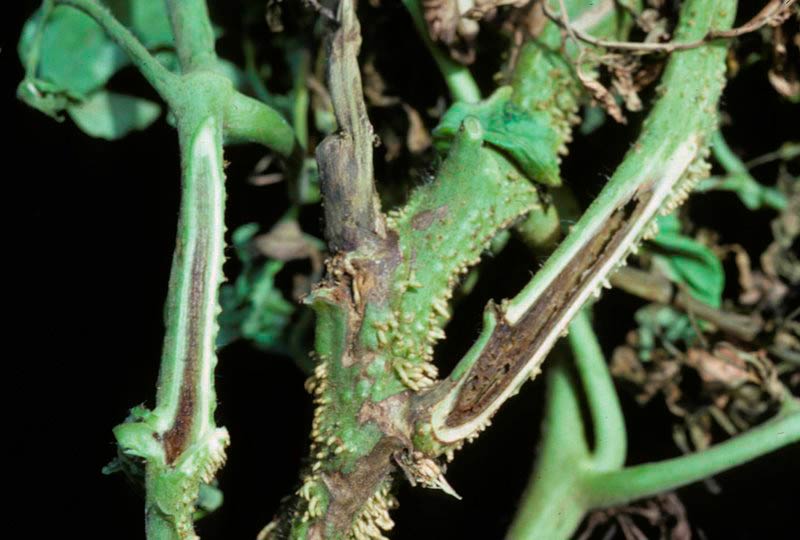
Necrosis of the stems overtakes the tomatoes during the formation and ripening of the fruit. The disease is caused by the bacterium "Pseudomonas corrugata". Scientists have not fully studied the nature of harmful microorganisms. Cure plants from the disease is impossible, but its appearance can be prevented. How to save tomatoes from bacterial scourge?
Symptoms of the disease
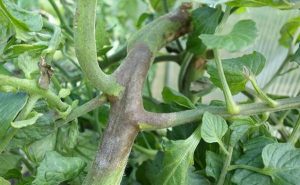 The first symptoms of the disease begin to manifest during the fruiting period. Necrosis is found on tall tomatoes that grow in greenhouse conditions. Begins to spread from the bottom of the plants. The stem is covered with depressed necrotic formations of emerald color. After a few days, the ulcers begin to crack and turn.
The first symptoms of the disease begin to manifest during the fruiting period. Necrosis is found on tall tomatoes that grow in greenhouse conditions. Begins to spread from the bottom of the plants. The stem is covered with depressed necrotic formations of emerald color. After a few days, the ulcers begin to crack and turn.
At the core of the stem are colonies of bacteria that clog the vascular system of a tomato. If you make a small cut on the plant, then after a while white mucus will begin to flow from the wound. The defeat of necrosis leads to the complete wilting of tomatoes. In stages, the disease develops as follows:
- Bacteria, through wounds on a plant or along the root system, infect tomatoes.
- The core becomes watery, then turns brown. The mucus fills the entire vascular system of the stem, as a result of which it begins to dry out gradually.
- At the bottom of the plant appear aerial roots. Initially, they are painted in a milky color, and then brown.
- The leaves begin to lose their elasticity, color. Sheet plate begins to dry.
- On the outer side of the stem, brown stripes are traced over the entire surface.
- The fruits are influenced by bacteria in the last place. Uncharacteristic veins begin to form on the tomatoes. Cutting the fruit, infected seeds are detected.
The active phase of the disease lasts for 2-3 weeks, after which, 70% of tomatoes wither, and the rest continue to grow, but they are very weak.
The causes of the disease
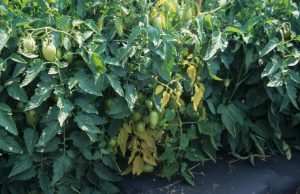 The development of necrosis on tomatoes contributes to:
The development of necrosis on tomatoes contributes to:
- The sharp decrease in air temperature at night.
- Excessive nitrogen fertilization.
- Constant high humidity of air and soil.
- Failure to comply with agrotechnical measures to remove weeds, destroy insects that can infect healthy tomatoes.
- Use non-sanitized garden tools that can infect tomatoes during the nursing process.
Core necrosis of tomato stalks remains on dried plants for up to five months. Therefore, infected bushes need to be pulled out of the greenhouse and burned outside.
Measures to combat necrosis
Rescue infected tomatoes is not possible. Therefore, it remains only to destroy them and decontaminate the soil. You can process contaminated soil in the greenhouse:
- The drug "Fitolavin-300", which is a complex antibiotic in the fight against various harmful bacteria and fungi. To disinfect the soil, you will need to dissolve 20 milliliters of a liquid preparation in ten liters of water. Pour the resulting solution into a watering can, water the areas of the greenhouse where sore bushes grew. Consumption per square meter of soil is 5 liters.
- Potassium permanganate solution. Preparation of potassium permanganate: dissolve 10 grams of potassium permanganate in 10 liters of water.Water the infected places in the greenhouse so that the soil is soaked for at least 15 centimeters.
Prevention of necrosis in the greenhouse
As a prevention, you can use three methods: agrotechnical, chemical and folk remedies.
Agrotechnical means of prevention
- normalized nitrogen fertilization in the soil;
- the cultivation of varieties resistant to necrosis: "Red Arrow F1", "Mayeva F1", "Resento F1";
- sowing healthy seed;
- immediate destruction of infected plants;
- maintaining a stable temperature regime day and night;
- airing greenhouses during the daytime;
- replacement of topsoil in greenhouses every few years.
Preventive measures using chemicals
- disinfecting the soil after harvesting in greenhouses using copper sulphate or other copper-containing substances. Prepare the soil: remove the tops of tomatoes, mulch, weeds, dig 10-15 centimeters deep, rake all large earthy clumps. Immediately prepare a disinfecting solution: dilute 100 grams of copper sulfate in ten liters of water. Cultivate the land;
- soaking seeds in a solution based on drugs that kill pathogenic bacteria and fungi. For dressing use "Baktofit" or "Fitolavin 300". Soaking in a solution based on "Baktofit": dissolve 1 milliliter of suspension in a half-liter jar of water at room temperature. Seeds placed in cheesecloth, tie and put in the mixture for a day. Preparation of the solution based on "Fitolavin 300": dissolve 1 milliliter of the drug in half liter of warm water. Soak no more than 3 hours.
Measure out 1 milliliter of a liquid preparation, it is easy using a conventional syringe. One cube equals one milliliter.
- spraying the green mass of tomatoes. Against bacterial diseases will help the drug "Trichodermin." In five liters of water to dissolve 5 grams of the drug, spray the plants completely. The first spraying to carry out 20 days after germination, and the second before flowering.
Folk remedies for the prevention of necrosis
- soaking planting material in aloe juice. Grind 5 sprigs of a flower to a mushy state. In the mixture, add 50 milliliters of water, stir, put the seeds in the bag. Soak the planting material for 24 hours;
- spraying infusion on garlic and potassium permanganate. Grind in a blender or meat grinder 100 grams of garlic cloves, pour 250 milliliters of water, leave for 24 hours. The resulting infusion filter, dilute with 10 liters of water, adding one gram of potassium permanganate. Tomatoes spray several times. The first is when the first 3-4 leaves will appear after entries. The second - before flowering.


